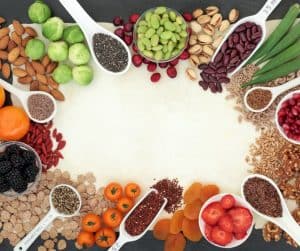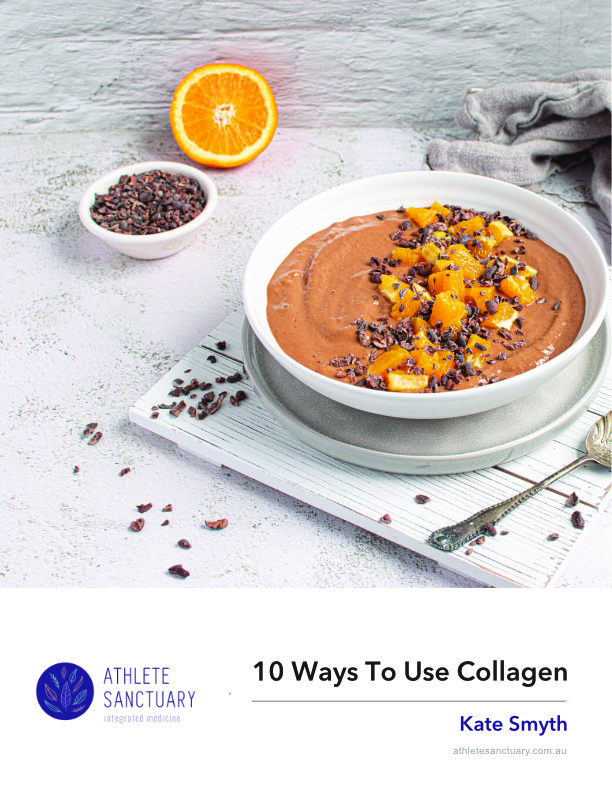

*By submitting this form you agree to receive our newsletter. It's only occasional and packed with good information!
Choosing the best collagen for tendon repair can be challenging. There are so many to choose from. All collagen powders are not created equal. Understanding the different forms and their sources can be helpful when making your decision. Keep in mind collagen can be helpful in the repair of tendons, bones and ligaments, improving skin elasticity and gut health.
Recent studies have helped to fine-tune dosage recommendations and nutrient combinations to enhance its effectiveness. As the quality and volume of collagen produced by our body reduces with age, master athletes may benefit from consistent supplementation.
Collagen is a major structural protein and building block made within your body. Collectively, collagen comprises 30% of the body’s protein as amino-acids, specifically glycine, proline, hydroxyproline and arginine. Collagen provides structure and acts like glue to your skin, hair, skeleton, tendons, muscles, ligaments, corneas, teeth and blood vessels. Hydrolysed collagen is similar to gelatin but structurally varies. Collagen contains tri peptides whereas gelatin contains simple amino acid chains. Peptide chains within collagen act as signalling molecules to fibroblasts which increase collagen, elastin and hyaluronic production. They also signal anti-inflammatory agents and increase the production of antioxidants.
There are 29 different types of collagen, all with slightly different roles but 80 – 90 % of the collagen in the body consists of types I, II, and III. Together all forms serve the same purpose; to help tissues withstand stretching. Although all forms are essential in the body, research tends to focus on types I-III when it comes to athletes. Let’s explore these three types in a little more detail.
Type I forms the reinforcing rods in bone, cartilage, tendons, teeth and connective tissue and is the most dominant form within the body making up 90% of all collagen. It is also the collagen that forms scar tissue and skin.
Type II (also known as hyaline or articular cartilage) is the major collagen in elastic cartilage and is the gel like substance designed to provide cushioning and allow joints to absorb shock. Its rigid macromolecules provide the strength and compressibility that allow it to resist large deformations in shape during movement.
Type III supports the structure of muscles, organs, and arteries.

Recent studies have also shown the combination of 500mg of vitamin C and between 5 – 15 grams of collagen is beneficial when taken one hour before exercise. Positive results do not appear to be dose dependent when within this range. Several studies including a study from the AIS (Australia Institute of Sport) showed significant improvements in achilles tendon injuries when taken for three to six months.
A 2017 study also demonstrated significant improvements in activity-related joint pain in 139 athletes, positive changes to ankle function and pain following supplementation for sprains. Collagen also reduces the risk of subsequent sprains for 3 months after supplementation.
Most collagen powders on the market are derived from shellfish, beef, chicken or pork. As a general recommendation, better quality collagen supplements are derived from grass-fed animals or wild-caught seafood. Vegans should be aware plants do not make collagen. There are currently no clinical trials that support bone broth as a reliable source of collagen peptides.
Vitamin C converts proline and glycine to hydroxyproline. Pre-clinical studies have also shown vitamin C has the potential to accelerate bone healing after a fracture, increased type I synthesis, and reduce oxidative stress.
Additional dietary intake of vitamin C-rich foods during rehabilitation may also be beneficial. Good sources include berries, red capsicum, broccoli, kiwi, guava, citrus, rosehip and indigenous foods such as camu camu, goji berry and Kakadu plum.
Copper also plays a role in production as it activates an enzyme called lysyl oxidase that is required for maturation. Copper is found in beef liver, crab, oysters, sunflower and sesame seeds, cocoa powder, cashews, hazelnuts, peanuts, almonds and lentils.
Zinc helps with the production and activates a protein that re–models collagen during wound healing. Zinc is found in seafood, oysters, pepitas, nuts, poultry and meat.
Manganese activates enzymes such as pro–lidase that your cells use to make proline and gives collagen fibres their shape. Brown rice, oats, pineapple, peanuts, and pecans all contain manganese.
Insufficient protein intake or overall energy intake impedes wound healing and increases inflammation to possibly deleterious levels. During the healing process, energy expenditure is increased, particularly if the injury is severe. Energy expenditure may increase between 15% – 50%, depending on the type and severity of the injury.
Given that muscle loss may begin from inactivity during an injury recovery phase within 36 hours and healing processes are heavily reliant on synthesis of collagen and other proteins, the importance of dietary protein should not be understated. If you are in the unfortunate position of being injured, protein intake of 2 grams/ kg of body weight per day is advocated.
Meat, poultry, seafood, dairy, legumes, and tofu are all excellent sources of amino acids. Plant-based athletes may combine protein sources to ensure all essential amino acids are available for protein synthesis.
In addition, specific foods rich in proline and glycine may be beneficial.
Proline is found in egg whites, wheat germ, dairy products, cabbage, asparagus, and mushrooms.
Glycine is found in the skin of pork or chicken and gelatin.
Making your own gelatin chews are an easy way to boost glycine intake.
Gelatin is what is used to set jelly and gummy lollies. Gelatin also contains proline, valine and glutamic acid.
Be wary of sugar! Sugar interferes with collagen’s ability to repair itself and degrades collagen. It is therefore a good idea to limit your consumption of added sugar and refined carbs when injured for several reasons.
Please remember the guidelines provided in this blog are general in nature. If you are injured, you may benefit from individualised nutritional guidance to help you get back on track. Make an appointment here
Kate Smyth is a Sports naturopath, nutritionist and female-centric running coach. She is the founder of the Athlete Sanctuary- a holistic healthcare clinic for athletes of all levels and sporting codes. Kate has a thirst for knowledge with two bachelor’s and a master’s degree under her belt. She has been involved in sports for many decades and competed for Australia in the Commonwealth Games and Olympic Games marathons with a personal best time of 2 hours 28 minutes. For more information visit https://athletesanctuary.com.au/kate-smyth/
Clark, K. L., Sebastianelli, W., Flechsenhar, K. R., Aukermann, D. F., Meza, F., Millard, R. L., & Albert, A. (2008). 24-Week study on the use of collagen hydrolysate as a dietary supplement in athletes with activity-related joint pain. Current medical research and opinion, 24(5), 1485-1496.
Dressler, P., Gehring, D., Zdzieblik, D., Oesser, S., Gollhofer, A., & König, D. (2018). Improvement of functional ankle properties following supplementation with specific collagen peptides in athletes with chronic ankle instability. Journal of sports science & medicine, 17(2), 298.
Frankenfield, D. (2006). Energy expenditure and protein requirements after traumatic injury. Nutrition in Clinical Practice, 21(5), 430-437.
Lis, D. M., & Baar, K. (2019). Effects of Different Vitamin C–Enriched Collagen Derivatives on Collagen Synthesis. International Journal of sports nutrition and exercise metabolism, 29(5), 526-531.
Praet, S. F., Purdam, C. R., Welvaert, M., Vlahovich, N., Lovell, G., Burke, L. M., & Waddington, G. (2019). Oral supplementation of specific collagen peptides combined with calf-strengthening exercises enhances function and reduces pain in achilles tendinopathy patients. Nutrients, 11(1), 76.
Shaw, G., Lee-Barthel, A., Ross, M. L., Wang, B., & Baar, K. (2017). Vitamin C–enriched gelatin supplementation before intermittent activity augments collagen synthesis. The American Journal of clinical nutrition, 105(1), 136-143.
Zdzieblik, D., Oesser, S., Gollhofer, A., & König, D. (2017). Improvement of activity-related knee joint discomfort following supplementation of specific collagen peptides. Applied Physiology, Nutrition, and Metabolism, 42(6), 588-595

*By submitting this form you agree to receive our newsletter. It's only occasional and packed with good information!

Kate Smyth is a sports naturopath, nutritionist and female-centric running coach. She is the founder of the Athlete Sanctuary – a holistic healthcare clinic for athletes of all levels and sporting codes.
Kate has a thirst for knowledge, with two bachelor’s and a master’s degree under her belt. She has been involved in sports for many decades and competed for Australia in the Commonwealth Games and Olympic Games marathons with a personal best time of 2 hours 28 minutes.
Targeted naturopathic care, nutrition and holistic coaching for active individuals.
Normatec Recovery systems- hire and purchase
Birregurra -28-30 Strachan Street,
Torquay- 20 Cantala Drive, Jan Juc
TELEHEALTH – Aus wide, New Zealand, Canada and globally (except US)
Melbourne and Ballarat clinics are currently online